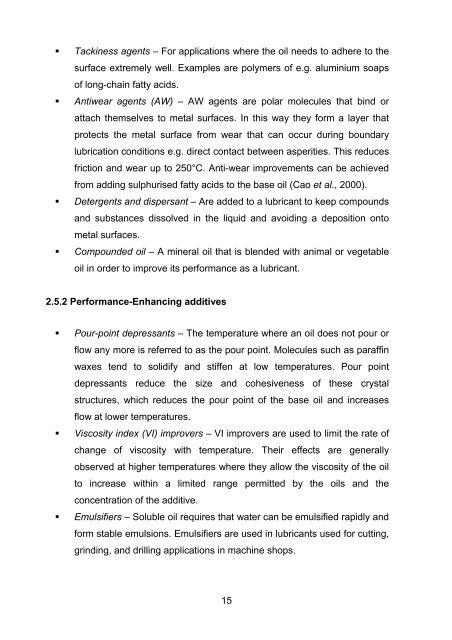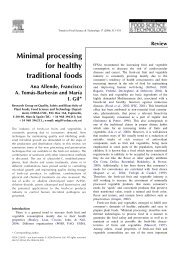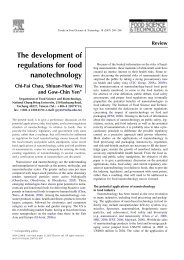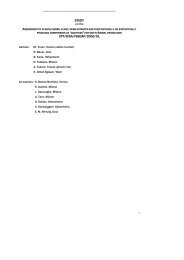production of wax esters in crambe
production of wax esters in crambe
production of wax esters in crambe
You also want an ePaper? Increase the reach of your titles
YUMPU automatically turns print PDFs into web optimized ePapers that Google loves.
• Tack<strong>in</strong>ess agents – For applications where the oil needs to adhere to the<br />
surface extremely well. Examples are polymers <strong>of</strong> e.g. alum<strong>in</strong>ium soaps<br />
<strong>of</strong> long-cha<strong>in</strong> fatty acids.<br />
• Antiwear agents (AW) – AW agents are polar molecules that b<strong>in</strong>d or<br />
attach themselves to metal surfaces. In this way they form a layer that<br />
protects the metal surface from wear that can occur dur<strong>in</strong>g boundary<br />
lubrication conditions e.g. direct contact between asperities. This reduces<br />
friction and wear up to 250°C. Anti-wear improvements can be achieved<br />
from add<strong>in</strong>g sulphurised fatty acids to the base oil (Cao et al., 2000).<br />
• Detergents and dispersant – Are added to a lubricant to keep compounds<br />
and substances dissolved <strong>in</strong> the liquid and avoid<strong>in</strong>g a deposition onto<br />
metal surfaces.<br />
• Compounded oil – A m<strong>in</strong>eral oil that is blended with animal or vegetable<br />
oil <strong>in</strong> order to improve its performance as a lubricant.<br />
2.5.2 Performance-Enhanc<strong>in</strong>g additives<br />
• Pour-po<strong>in</strong>t depressants – The temperature where an oil does not pour or<br />
flow any more is referred to as the pour po<strong>in</strong>t. Molecules such as paraff<strong>in</strong><br />
<strong>wax</strong>es tend to solidify and stiffen at low temperatures. Pour po<strong>in</strong>t<br />
depressants reduce the size and cohesiveness <strong>of</strong> these crystal<br />
structures, which reduces the pour po<strong>in</strong>t <strong>of</strong> the base oil and <strong>in</strong>creases<br />
flow at lower temperatures.<br />
• Viscosity <strong>in</strong>dex (VI) improvers – VI improvers are used to limit the rate <strong>of</strong><br />
change <strong>of</strong> viscosity with temperature. Their effects are generally<br />
observed at higher temperatures where they allow the viscosity <strong>of</strong> the oil<br />
to <strong>in</strong>crease with<strong>in</strong> a limited range permitted by the oils and the<br />
concentration <strong>of</strong> the additive.<br />
• Emulsifiers – Soluble oil requires that water can be emulsified rapidly and<br />
form stable emulsions. Emulsifiers are used <strong>in</strong> lubricants used for cutt<strong>in</strong>g,<br />
gr<strong>in</strong>d<strong>in</strong>g, and drill<strong>in</strong>g applications <strong>in</strong> mach<strong>in</strong>e shops.<br />
15









